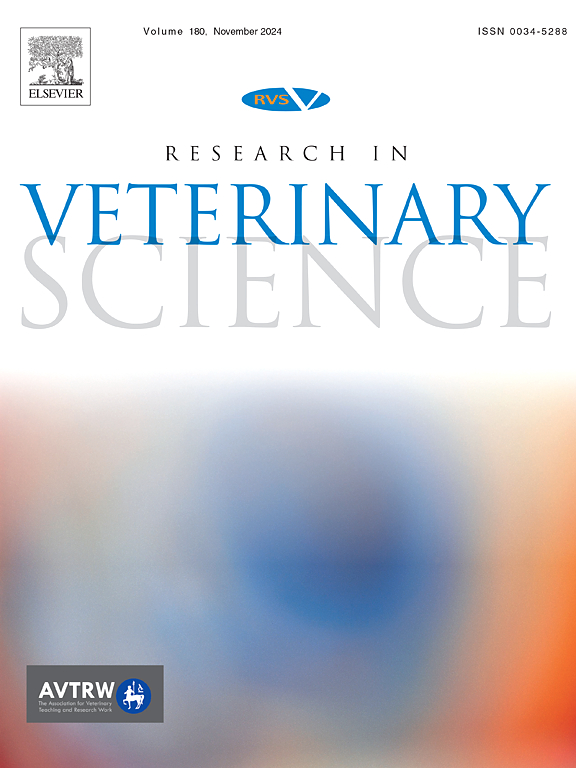RNA-sequencing transcriptomic analysis of scrapie-exposed ovine mesenchymal stem cells
IF 2.2
3区 农林科学
Q1 VETERINARY SCIENCES
引用次数: 0
Abstract
In neurodegenerative diseases, including prion diseases, cellular models arise as useful tools to study the pathogenic mechanisms occurring in these diseases and to assess the efficacy of potential therapeutic compounds. In the present study, a RNA-sequencing analysis of bone marrow-derived ovine mesenchymal stem cells (oBM-MSCs) exposed to scrapie brain homogenate was performed to try to unravel genes and pathways potentially involved in prion diseases and MSC response mechanisms to prions. The oBM-MSCs were cultured in three different conditions (inoculated with brain homogenate of scrapie-infected sheep, with brain homogenate of healthy sheep and in standard growth conditions without inoculum) that were analysed at two exposure times: 2 and 4 days post-inoculation (dpi). Differentially expressed genes (DEGs) in scrapie-treated oBM-MSCs were found in the two exposure times finding the higher number at 2 dpi, which coincided with the inoculum removal time. Pathways enriched in DEGs were related to biological functions involved in prion toxicity and MSC response to the inflammatory environment of scrapie brain homogenate. Moreover, RNA-sequencing analysis was validated amplifying by RT-qPCR a set of 11 DEGs with functions related with prion propagation and its associated toxicity. Seven of these genes displayed significant expression changes in scrapie-treated cells. These results contribute to the knowledge of the molecular mechanisms behind the early toxicity observed in these cells after prion exposure and to elucidate the response of MSCs to neuroinflammation.
对暴露于刮伤病的绵羊间充质干细胞进行 RNA 序列转录组分析
在神经退行性疾病(包括朊病毒疾病)中,细胞模型是研究这些疾病致病机制和评估潜在治疗化合物疗效的有用工具。在本研究中,对暴露于豚鼠瘙痒症脑匀浆的骨髓来源的绵羊间充质干细胞(oBM-MSCs)进行了RNA测序分析,试图揭示可能与朊病毒疾病有关的基因和通路,以及间充质干细胞对朊病毒的反应机制。在三种不同条件下培养 oBM-间充质干细胞(接种瘙痒病感染绵羊的脑匀浆、接种健康绵羊的脑匀浆和在标准生长条件下不接种),在两个暴露时间进行分析:接种后 2 天和 4 天(dpi)。在两个暴露时间段内,均发现了经刮伤病处理的 oBM-MSCs 中的差异表达基因(DEGs),其中 2 dpi 的差异表达基因数量较多,这与移除接种体的时间相吻合。DEGs富集的通路与朊病毒毒性和间充质干细胞对刮伤脑匀浆炎症环境的反应相关。此外,RNA 序列分析还验证了通过 RT-qPCR 扩增的 11 个 DEGs,这些 DEGs 的功能与朊病毒的传播及其相关毒性有关。其中七个基因在经刮伤病处理的细胞中显示出明显的表达变化。这些结果有助于了解朊病毒暴露后在这些细胞中观察到的早期毒性背后的分子机制,并有助于阐明间充质干细胞对神经炎症的反应。
本文章由计算机程序翻译,如有差异,请以英文原文为准。
求助全文
约1分钟内获得全文
求助全文
来源期刊

Research in veterinary science
农林科学-兽医学
CiteScore
4.40
自引率
4.20%
发文量
312
审稿时长
75 days
期刊介绍:
Research in Veterinary Science is an International multi-disciplinary journal publishing original articles, reviews and short communications of a high scientific and ethical standard in all aspects of veterinary and biomedical research.
The primary aim of the journal is to inform veterinary and biomedical scientists of significant advances in veterinary and related research through prompt publication and dissemination. Secondly, the journal aims to provide a general multi-disciplinary forum for discussion and debate of news and issues concerning veterinary science. Thirdly, to promote the dissemination of knowledge to a broader range of professions, globally.
High quality papers on all species of animals are considered, particularly those considered to be of high scientific importance and originality, and with interdisciplinary interest. The journal encourages papers providing results that have clear implications for understanding disease pathogenesis and for the development of control measures or treatments, as well as those dealing with a comparative biomedical approach, which represents a substantial improvement to animal and human health.
Studies without a robust scientific hypothesis or that are preliminary, or of weak originality, as well as negative results, are not appropriate for the journal. Furthermore, observational approaches, case studies or field reports lacking an advancement in general knowledge do not fall within the scope of the journal.
 求助内容:
求助内容: 应助结果提醒方式:
应助结果提醒方式:


